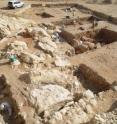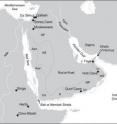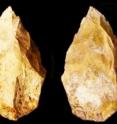Modern humans reached Arabia earlier than thought, new artifacts suggest
Related images
(click to enlarge)
The timing and dispersal of modern humans out of Africa has been the source of long-standing debate, though most evidence has pointed to an exodus along the Mediterranean Sea or along the Arabian coast approximately 60,000 years ago. This new research, placing early humans on the Arabian Peninsula much earlier, will appear in the 28 January issue of Science, which is published by AAAS, the nonprofit science society.
The team of researchers, including lead author Simon Armitage from Royal Holloway, University of London, discovered an ancient human toolkit at the Jebel Faya archaeological site in the United Arab Emirates. It resembles technology used by early humans in east Africa but not the craftsmanship that emerged from the Middle East, they say. This toolkit includes relatively primitive hand-axes along with a variety of scrapers and perforators, and its contents imply that technological innovation was not necessary for early humans to migrate onto the Arabian Peninsula. Armitage calculated the age of the stone tools using a technique known as luminescence dating and determined that the artifacts were about 100,000 to 125,000 years old.
"These 'anatomically modern' humans — like you and me — had evolved in Africa about 200,000 years ago and subsequently populated the rest of the world," said Armitage. "Our findings should stimulate a re-evaluation of the means by which we modern humans became a global species."
Uerpmann and his team also analyzed sea-level and climate-change records for the region during the last interglacial period, approximately 130,000 years ago. They determined that the Bab al-Mandab Strait, which separates Arabia from the Horn of Africa, would have narrowed due to lower sea-levels, allowing safe passage prior to and at the beginning of that last interglacial period. At that time, the Arabian Peninsula was much wetter than today with greater vegetation cover and a network of lakes and rivers. Such a landscape would have allowed early humans access into Arabia and then into the Fertile Crescent and India, according to the researchers.
"Archaeology without ages is like a jigsaw with the interlocking edges removed — you have lots of individual pieces of information but you can't fit them together to produce the big picture," said Armitage. "At Jebel Faya, the ages reveal a fascinating picture in which modern humans migrated out of Africa much earlier than previously thought, helped by global fluctuations in sea-level and climate change in the Arabian Peninsula."
Source: American Association for the Advancement of Science
Other sources
- Humans left Africa 65,000 years earlier: studyfrom Reuters:ScienceFri, 28 Jan 2011, 22:10:22 UTC
- Ancestors may have left Africa earlier than thoughtfrom LA Times - ScienceFri, 28 Jan 2011, 6:30:17 UTC
- Humans left Africa 65,000 years earlier: studyfrom Reuters:ScienceFri, 28 Jan 2011, 5:40:10 UTC
- Date of humans out of Africa pushed backfrom UPIFri, 28 Jan 2011, 1:00:31 UTC
- Humans May Have Left Africa Earlier than Thoughtfrom CBSNews - ScienceFri, 28 Jan 2011, 0:20:22 UTC
- Hints of earlier human exit from Africafrom Sciencenews.orgThu, 27 Jan 2011, 21:50:59 UTC
- Modern humans may have left Africa earlier than thoughtfrom MSNBC: ScienceThu, 27 Jan 2011, 21:30:28 UTC
- Modern humans reached Arabia earlier than thought, new artifacts suggestfrom Science DailyThu, 27 Jan 2011, 21:11:22 UTC
- Early human migration written in stone toolsfrom News @ NatureThu, 27 Jan 2011, 20:30:22 UTC
- Humans Left Africa Earlier, During Ice Age Heat Wavefrom National GeographicThu, 27 Jan 2011, 20:20:40 UTC
- Humans May Have Left Africa Earlier than Thoughtfrom CBSNews - ScienceThu, 27 Jan 2011, 20:20:39 UTC
- Stone tools discovered in Arabia force archaeologists to rethink human historyfrom The Guardian - ScienceThu, 27 Jan 2011, 20:20:09 UTC
- Humans 'left Africa much earlier'from BBC News: Science & NatureThu, 27 Jan 2011, 20:00:40 UTC
- Humans left Africa 65,000 years earlier: studyfrom Reuters:ScienceThu, 27 Jan 2011, 19:50:20 UTC
- Tools Suggest Earlier Human Exit From Africafrom NY Times ScienceThu, 27 Jan 2011, 19:50:09 UTC
- Modern humans reached Arabia earlier than thought, new artifacts suggestfrom PhysorgThu, 27 Jan 2011, 19:40:18 UTC
- Early human migration written in stone toolsfrom News @ NatureThu, 27 Jan 2011, 19:31:57 UTC
- Ancient Arabian Artifacts May Rewrite ‘Out of Africa’ Storyfrom Live ScienceThu, 27 Jan 2011, 19:31:49 UTC
- Humans may have left Africa earlier than thoughtfrom AP ScienceThu, 27 Jan 2011, 19:31:45 UTC


